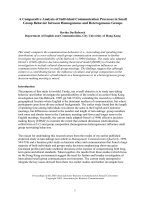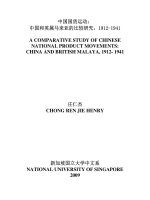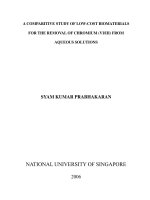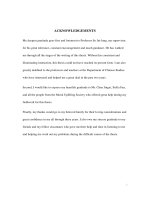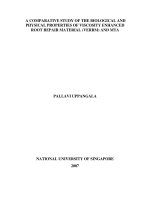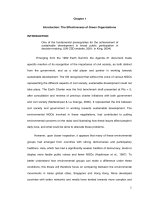a comparative study of publicly listed companies in singapore and vietnam
Bạn đang xem bản rút gọn của tài liệu. Xem và tải ngay bản đầy đủ của tài liệu tại đây (2.95 MB, 302 trang )
CORPORATE GOVERNANCE STRUCTURES
AND FINANCIAL PERFORMANCE:
A COMPARATIVE STUDY OF PUBLICLY LISTED
COMPANIES IN SINGAPORE AND VIETNAM
A thesis
submitted in fulfilment
of the requirements for the degree
of
Doctor of Philosophy in Finance
at
The University of Waikato
By
TUAN VAN NGUYEN
2015
This page intentionally left blank
ii
ABSTRACT
This study uses a dynamic modelling approach to investigate the relationship
between corporate governance structures and financial performance of publicly
listed companies in Singapore and Vietnam. The dynamic modelling approach
facilitates answering the first research question: whether the relationship between
corporate governance structures and firm financial performance persists in the
Singaporean and Vietnamese markets when the relationship’s dynamic nature is
taken into account. Moreover, by focusing on two different types of national
governance systems in the Asian region (well-developed vs. under-developed),
this study observes how the relationship between corporate governance structures
and firm performance is moderated by each country’s national governance quality.
By carrying out this observation, this study answers the second research question:
whether the corporate governance–firm performance relationship varies according
to the quality of national governance systems in which firms operate.
Two samples – including a total of 379 publicly listed non-financial companies1
covering a four-year period from 2008 to 2011– are examined through the use of a
two-step system generalised method of moments estimator. This estimation
technique allows for potential sources of endogeneity inherent in the corporate
governance–firm performance relationship, including dynamic endogeneity,
simultaneity, and unobserved time-invariant heterogeneity across firms.
The results suggest that the performance effect of corporate governance structures
persists in both markets even after the dynamic nature of the corporate
1
There are 122 companies for the Vietnamese market and 257 companies for the
Singaporean market.
iii
governance–firm performance relationship is taken into consideration. For the
Singaporean market, the results also show that the three corporate governance
structures (board diversity, board size and ownership structures) appear to have
statistically significant effects on firm performance. For both markets, it is
observed that there is a statistically significantly positive relationship between
ownership concentration and financial performance. This finding supports the
prediction of agency theory regarding the efficient monitoring effect of large
shareholders in markets with highly concentrated ownership.
For the Vietnamese market, the results show that board gender diversity has a
positive effect on firm performance. Remaining robust even after the alternative
proxies for gender diversity are employed, this finding is consistent with the
perspectives of agency theory and resource dependence theory. The number of
female directors in the boardroom also matters, supporting the view that if female
board representation affects firm outcomes, this effect is more pronounced when
the number of female directors increases. However, the marginal positive
performance effect of board gender diversity ceases when the percentage of
female directors reaches a breakpoint of about 20%. This finding suggests that
there is perhaps a potential trade-off between the costs and benefits of board
gender diversity.
Importantly, the results indicate that the relationship between the current
performance and one-year lagged performance is statistically significantly
positive in both markets, and robust when alternative estimation methods and
models are employed. In line with Wintoki, Linck, and Netter (2012), among
others, this finding suggests that the corporate governance–firm performance
iv
relationship should be investigated in a dynamic framework. This means that past
firm performance should be considered as an important independent variable to
control for potential effects of unobserved historical factors on current corporate
governance structures and performance.
Furthermore, the results show that better national governance quality has a
positive effect on firm performance, and that the performance effect of ownership
concentration is contingent upon national governance quality. The results suggest
that ownership concentration appears to have a stronger positive effect on
performance of companies in Vietnam where the national governance system is
underdeveloped. In contrast, concentrated ownership tends to have a weaker effect
on financial performance of firms in Singapore where the national governance
system is well-established. This finding is consistent with the argument that
ownership concentration is an efficient corporate governance mechanism which
can substitute for weak national governance quality. In the absence of effective
national governance mechanisms, ownership concentration is likely to be an
important corporate governance strategy for Vietnamese firms to control potential
agency problems. On the contrary, in Singapore, where national governance
quality – such as legal protection of shareholders – is much better, the role of
ownership concentration in determining performance seems to be weaker.
This study is novel in that it is the first to explore the corporate governance–firm
performance relationship using a dynamic modelling approach for the Vietnamese
and Singaporean markets. The findings of this study significantly contribute
toward a better understanding of international diversity on corporate governance
by providing robust empirical evidence from the emerging and mature markets in
v
the Asian region. This study also extends the corporate governance literature by
enriching the understanding of the interaction between corporate-level and
national-level governance mechanisms.
vi
THESIS RELATED RESEARCH OUTCOMES
A number of refereed journal articles and conference papers have been produced
from this thesis as follows.
REFERRED JOURNAL ARTICLES
Nguyen, T., Locke, S., & Reddy, K. (2014). A dynamic estimation of governance
structures and financial performance for Singaporean companies.
Economic Modelling, 40(C), 1-11. [SSCI]. [ABDC: A].
Nguyen, T., Locke, S., & Reddy, K. (2015). Does boardroom gender diversity
matter? Evidence from a transitional economy. International Review of
Economics and Finance, 37(C), 184-202. [SSCI]. [ABDC: A].
REFERRED CONFERENCE PAPERS
Nguyen, T., Locke, S., & Reddy, K. (2012). Do female directors add value?
Evidence from an emerging market. Paper presented at the 16th Annual
Waikato Management School Student Research Conference, University of
Waikato, Hamilton, New Zealand.
Nguyen, T., Locke, S., & Reddy, K. (2014). A dynamic estimation of governance
structures and financial performance for Singaporean companies. Paper
presented at the 18th New Zealand Finance Colloquium (PhD
Symposium), AUT Business School, Auckland University of Technology,
Auckland, New Zealand.
Nguyen, T., Locke, S., & Reddy, K. (2015). Ownership concentration and
corporate performance from a dynamic perspective: Does national
governance quality matter? Paper presented at the 19th New Zealand
Finance Colloquium (PhD Symposium), Waikato Management School,
University of Waikato, Hamilton, New Zealand2.
2
Another version of this paper was presented at the 2014 Department of Finance
Seminar Series, Waikato Management School, University of Waikato, Hamilton, New
Zealand.
vii
This page intentionally left blank
viii
ACKNOWLEDGMENTS
This thesis would not have been possible and my four-year PhD journey would
certainly have been much less enjoyable without the kind help and strong support
from others around me. I would, therefore, like to start these acknowledgments by
expressing my heartfelt gratitude to my chief supervisor, Professor Stuart Locke,
for his valuable advice, comments, and suggestions. His constant encouragement
and strong support has been invaluable, especially when I was having a hard time
with the formal research proposal writing stage. I would also like to specially
thank my co-supervisor, Dr Krishna Reddy, for his helpful comments and detailed
feedback on draft versions of my papers and thesis.
I would like to extend my thanks to all staff in the Department of Finance,
Waikato Management School, for their contributions to the seminars which
provided me with a helpful and friendly academic environment. I thank our
Department administrators, Ms. Maria Fitzgerald (before) and Ms. Denise Martin
(current), who organised the research facilities and assisted me with paperwork. I
also gratefully acknowledge the Government of Vietnam for the scholarship for
my PhD study in New Zealand; and the Department of Finance, Waikato
Management School for its financial support for presenting my papers at
academic conferences.
I would like to thank StoxPlus Corporation for providing Vietnamese data. I thank
my PhD fellows, especially Azilawati for her advice on how to effectively extract
data from Thomson One Banker database; and Noor, Tấn, Thu, Tuyến, and XiaoJun, who helped and encouraged me, discussed and shared great ideas not only in
research but also in my daily life.
I owe Quỳnh Nhuệ, my dear wife, a great debt of gratitude for her sympathy, love,
and assistance in making this thesis a reality. Finally, but no less important, I wish
to tell Xuân Phương, my beloved daughter, that words cannot express how happy
I was that she was with me during my PhD research journey. It is to her that I
dedicate this thesis.
Nguyễn Văn Tuấn
ix
This page intentionally left blank
x
GENERAL TABLE OF CONTENTS
ABSTRACT ......................................................................................................... III
THESIS RELATED RESEARCH OUTCOMES .......................................... VII
ACKNOWLEDGMENTS .................................................................................. IX
GENERAL TABLE OF CONTENTS ............................................................... XI
DETAILED TABLE OF CONTENTS ........................................................... XIII
LIST OF ABBREVIATIONS ......................................................................... XIX
LIST OF TABLES ........................................................................................... XXI
LIST OF FIGURES ........................................................................................ XXV
LIST OF APPENDICES ............................................................................. XXVII
CHAPTER 1 INTRODUCTION ......................................................................... 1
CHAPTER 2 LITERATURE REVIEW AND RESEARCH HYPOTHESES
............................................................................................................................... 17
CHAPTER 3 INSTITUTIONAL BACKGROUND OF CORPORATE
GOVERNANCE IN SINGAPORE AND VIETNAM ...................................... 47
CHAPTER 4 DATA AND METHOD ............................................................... 67
CHAPTER 5 CORPORATE GOVERNANCE STRUCTURES AND FIRM
PERFORMANCE IN VIETNAM ................................................................... 121
CHAPTER 6 CORPORATE GOVERNANCE STRUCTURES AND FIRM
PERFORMANCE IN SINGAPORE ............................................................... 167
CHAPTER 7 CORPORATE GOVERNANCE STRUCTURES AND FIRM
PERFORMANCE: A COMPARATIVE ANALYSIS BETWEEN AN
EMERGING MARKET AND A MATURE MARKET ................................ 193
CHAPTER 8 CONCLUSIONS, IMPLICATIONS AND LIMITATIONS . 239
APPENDIXES ................................................................................................... 251
REFERENCES .................................................................................................. 259
xi
This page intentionally left blank
xii
DETAILED TABLE OF CONTENTS
ABSTRACT ......................................................................................................... III
THESIS RELATED RESEARCH OUTCOMES .......................................... VII
ACKNOWLEDGMENTS .................................................................................. IX
GENERAL TABLE OF CONTENTS ............................................................... XI
DETAILED TABLE OF CONTENTS ........................................................... XIII
LIST OF ABBREVIATIONS ......................................................................... XIX
LIST OF TABLES ........................................................................................... XXI
LIST OF FIGURES ........................................................................................ XXV
LIST OF APPENDICES ............................................................................. XXVII
CHAPTER 1 INTRODUCTION ......................................................................... 1
1.0 OUTLINE ............................................................................................................ 1
1.1 MOTIVATION AND RESEARCH QUESTIONS .......................................................... 2
1.1.1 Why should a dynamic modelling approach be used? ............................. 2
1.1.2 Why should national governance quality be involved? ........................... 5
1.1.3 Why Singapore and Vietnam? ................................................................. 6
1.2 SIGNIFICANCE OF THE STUDY............................................................................. 8
1.3 ORGANISATION OF THE THESIS ........................................................................ 14
1.4 SUMMARY ....................................................................................................... 15
CHAPTER 2 LITERATURE REVIEW AND RESEARCH HYPOTHESES
............................................................................................................................... 17
2.0 INTRODUCTION ................................................................................................ 17
2.1 DEFINITIONS OF CORPORATE GOVERNANCE ..................................................... 17
2.2 THREE DOMINANT THEORIES IN CORPORATE GOVERNANCE RESEARCH: AN
OVERVIEW ....................................................................................................... 19
2.2.1 Agency theory ........................................................................................ 21
2.2.2 Resource dependence theory.................................................................. 22
2.2.3 Institutional theory and its role in cross-national comparative studies of
corporate governance ............................................................................. 23
2.3 CORPORATE GOVERNANCE STRUCTURES AND FIRM FINANCIAL PERFORMANCE 26
2.3.1 Board structure and firm financial performance .................................... 27
xiii
2.3.1.1
Board diversity and firm financial performance...................................... 27
2.3.1.2
Board composition and firm financial performance ................................ 32
2.3.1.3
Board leadership structure and firm financial performance .................... 34
2.3.1.4
Board size and firm financial performance ............................................. 36
2.3.2 Ownership structure and firm financial performance ............................. 39
2.3.3 Capital structure and firm financial performance................................... 42
2.4 NATIONAL GOVERNANCE QUALITY AND FIRM FINANCIAL PERFORMANCE ........ 43
2.5 MODERATING EFFECT OF NATIONAL GOVERNANCE QUALITY ON THE
RELATIONSHIP BETWEEN CORPORATE GOVERNANCE STRUCTURES AND
FINANCIAL PERFORMANCE ............................................................................... 44
2.6 SUMMARY ........................................................................................................ 45
CHAPTER 3 INSTITUTIONAL BACKGROUND OF CORPORATE
GOVERNANCE IN SINGAPORE AND VIETNAM ...................................... 47
3.0 INTRODUCTION ................................................................................................ 47
3.1 CORPORATE GOVERNANCE IN SINGAPORE ....................................................... 47
3.1.1 Corporate governance regulatory system in Singapore .......................... 47
3.1.2 The context of corporate governance in Singapore ................................ 49
3.2 CORPORATE GOVERNANCE IN VIETNAM .......................................................... 50
3.2.1 Corporate governance regulatory system in Vietnam ............................ 50
3.2.2 The context of corporate governance in Vietnam .................................. 52
3.3 CORPORATE GOVERNANCE IN SINGAPORE AND VIETNAM: A COMPARATIVE
ANALYSIS ......................................................................................................... 55
3.4 NATIONAL INSTITUTIONS IN SINGAPORE AND VIETNAM .................................. 59
3.4.1 National governance quality in Vietnam and Singapore ........................ 59
3.4.2 Gender-related institutional environment in Vietnam ............................ 62
3.5 SUMMARY ........................................................................................................ 64
CHAPTER 4 DATA AND METHOD ............................................................... 67
4.0 INTRODUCTION ................................................................................................ 67
4.1 CONCEPTUAL FRAMEWORK .............................................................................. 67
4.2 SAMPLE SELECTION AND DATA ........................................................................ 69
4.2.1 Data sources ........................................................................................... 69
4.2.1.1
Data sources for Vietnam ........................................................................ 69
4.2.1.2
Data sources for Singapore ...................................................................... 70
4.2.1.3
Data sources for national governance quality variables .......................... 71
4.2.2 The criteria for data collection ............................................................... 71
4.2.3 Data sample ............................................................................................ 75
xiv
4.3 RESEARCH METHOD ......................................................................................... 80
4.3.1 Endogeneity and the dynamic of corporate governance–financial
performance relationship........................................................................ 80
4.3.2 Variables ................................................................................................ 83
4.3.2.1
Dependent variables ................................................................................ 83
4.3.2.2
Firm-level explanatory variables ............................................................. 85
4.3.2.3
National governance quality variables .................................................... 90
4.3.2.4
Other control variables ............................................................................ 92
4.3.3 Model specifications ............................................................................ 104
4.3.3.1
The general model ................................................................................. 104
4.3.3.2
The model specification for the Vietnamese market ............................. 106
4.3.3.3
The model specification for the Singaporean market ............................ 108
4.3.3.4
The model specification for the combined dataset of both markets ...... 109
4.3.4 Estimation approaches ......................................................................... 111
4.3.5 Specification tests for the System GMM model .................................. 116
4.3.5.1
Durbin-Wu-Hausman (DWH) test for endogeneity of regressors ......... 116
4.3.5.2
Testing over-identifying restrictions ..................................................... 117
4.4 SUMMARY ..................................................................................................... 118
CHAPTER 5 CORPORATE GOVERNANCE STRUCTURES AND FIRM
PERFORMANCE IN VIETNAM ................................................................... 121
5.0 INTRODUCTION .............................................................................................. 121
5.1 PRELIMINARY DATA ANALYSIS ...................................................................... 122
5.1.1 Descriptive statistics ............................................................................ 124
5.1.2 Correlation matrix and multi-collinearity diagnostic ........................... 132
5.1.3 The slow-changing characteristic of corporate governance variables . 135
5.2 MULTIPLE REGRESSION ANALYSIS ................................................................. 137
5.2.1 Static vs. dynamic models: Pooled OLS and FE estimations .............. 137
5.2.1.1
The static models................................................................................... 137
5.2.1.2
The dynamic models ............................................................................. 141
5.2.2 Dynamic models: A System GMM estimation .................................... 146
5.2.2.1
Testing for endogeneity of the regressors ............................................. 146
5.2.2.2
The validity of the System GMM estimator .......................................... 146
5.2.2.3
Empirical results from the System GMM model .................................. 147
5.2.3 Robustness checks ............................................................................... 149
5.2.3.1
The sensitivity of the results to the reduction of instruments ................ 149
5.2.3.2
Robustness check with alternative corporate governance variables...... 156
xv
5.3 SUMMARY ...................................................................................................... 164
CHAPTER 6 CORPORATE GOVERNANCE STRUCTURES AND FIRM
PERFORMANCE IN SINGAPORE ............................................................... 167
6.0 INTRODUCTION .............................................................................................. 167
6.1 PRELIMINARY DATA ANALYSIS ...................................................................... 167
6.1.1 Descriptive statistics ............................................................................. 169
6.1.2 Correlation matrix and multi-collinearity diagnostic ........................... 172
6.1.3 The slow-changing characteristic of corporate governance variables .. 173
6.2 MULTIPLE REGRESSION ANALYSIS ................................................................. 175
6.2.1 Static vs. dynamic models: Pooled OLS and FE estimations............... 176
6.2.2 Dynamic models: A System GMM estimation .................................... 178
6.2.2.1
Testing for endogeneity of the regressors.............................................. 178
6.2.2.2
The validity of the System GMM estimator .......................................... 179
6.2.2.3
Empirical results from the System GMM model ................................... 181
6.2.3 Robustness checks ................................................................................ 185
6.2.3.1
The sensitivity of the results to the reduction of instruments ................ 186
6.2.3.3
Robustness check with alternative corporate governance variables ...... 188
6.3 SUMMARY ...................................................................................................... 190
CHAPTER 7 CORPORATE GOVERNANCE STRUCTURES AND FIRM
PERFORMANCE: A COMPARATIVE ANALYSIS BETWEEN AN
EMERGING MARKET AND A MATURE MARKET ................................ 193
7.0 INTRODUCTION .............................................................................................. 193
7.1 THE RELATIONSHIP BETWEEN CORPORATE GOVERNANCE STRUCTURES AND
PERFORMANCE: EVIDENCE FROM A CROSS-COUNTRY COMPARISON .............. 194
7.1.1 A comparison of corporate governance structures and firm performance
between Singapore and Vietnam .......................................................... 194
7.1.1.1
The difference in the means of numerical variables between Singapore
and Vietnam........................................................................................... 195
7.1.1.2
The difference in the proportions of categorical variables between
Singapore and Vietnam ......................................................................... 203
7.1.2 A cross-country comparative analysis of corporate governance
structures–firm performance relationship............................................. 205
7.1.2.1
Dynamic nature of the corporate governance–firm performance
relationship in Singapore and Vietnam ................................................. 205
7.1.2.2
Board diversity and firm performance................................................... 207
7.1.2.3
Board composition and firm performance ............................................. 209
7.1.2.4
Board leadership structure and firm performance ................................. 210
7.1.2.5
Board size and firm performance .......................................................... 211
xvi
7.1.2.6
Ownership concentration and firm performance ................................... 212
7.1.2.7
Capital structure and firm performance................................................. 212
7.2 THE RELATIONSHIP BETWEEN CORPORATE GOVERNANCE STRUCTURES AND FIRM
PERFORMANCE: DOES NATIONAL GOVERNANCE QUALITY MATTER? .............. 214
7.2.1 Descriptive statistics ............................................................................ 214
7.2.2 Correlation matrix and multi-collinearity diagnostic ........................... 218
7.2.3 Multiple regression analysis ................................................................ 221
7.2.3.1
Empirical findings from the combined dataset of both markets: The
pooled OLS and FE models .................................................................. 221
7.2.3.2
Empirical findings from the combined dataset of both markets: The
System GMM models............................................................................ 222
7.2.3.3
Does national governance quality matter? ............................................ 227
7.2.4 Robustness checks ............................................................................... 232
7.2.4.1
Robustness check for the possible non-linearity in the ownership
structure–performance relationship ....................................................... 232
7.2.4.2
Robustness check with alternative national governance quality variables
............................................................................................................... 234
7.3 SUMMARY ..................................................................................................... 237
CHAPTER 8 CONCLUSIONS, IMPLICATIONS AND LIMITATIONS . 239
8.0 INTRODUCTION .............................................................................................. 239
8.1 CONTRIBUTIONS AND IMPLICATIONS ............................................................. 239
8.1.1 A summary of key findings and policy implications ........................... 239
8.1.2 The contributions of the thesis ............................................................. 243
8.2 LIMITATIONS AND RECOMMENDATIONS FOR FUTURE RESEARCH ................... 244
8.3 SUMMARY ..................................................................................................... 250
APPENDIXES ................................................................................................... 251
REFERENCES .................................................................................................. 259
xvii
This page intentionally left blank
xviii
LIST OF ABBREVIATIONS
AB AR(2) test
The Arellano-Bond test for second-order serial correlation
ADB
The Asian Development Bank
AR(1)
The first-order autoregressive process
ASEAN
The Association of Southeast Asian Nations
BOD
Board of directors
BOS
Board of supervisors
CEO
Chief executive officer
CGIO
The Centre for Governance, Institutions and
Organisations [Business School , National University of
Singapore]
CLSA
The Credit Lyonnais Securities Asia
DWH
The Durbin-Wu-Hausman test for endogeneity
FE
Fixed-effects [within-groups] estimator
GDP
The gross domestic product
GLCs
The government-linked companies [in Singapore]
GMS
General meeting of shareholders
GNI
The gross national income
HKEC
The Hong Kong Exchanges and Clearing Limited
HNX
The Hanoi Stock Exchange [Vietnam]
HOSE
The Ho-Chi-Minh Stock Exchange [Vietnam]
ICB
The Industry Classification Benchmark
IFC
The International Finance Corporation
IPO
Initial public offering
IV methods
Instrumental variable methods
LOCI
The [Vietnamese] Law on Credit Institutions
LOE 2005
The [Vietnamese] Law on Enterprises 2005
xix
MAS
The Monetary Authority of Singapore
MOF
The [Vietnamese] Ministry of Finance
OECD
The Organisation for Economic Co-operation and
Development
OLS
Ordinary least squares estimator
RE
Random-effects estimator
ROA
Return on assets
SGX
The Singapore Exchange Limited
Singaporean Code
The [Singaporean] Code of Corporate Governance 2005
SSC
The [Vietnamese] State Securities Commission
System GMM
The system generalised method of moments estimator
The UK
The United Kingdom
The US
The United States of America
UNIDO
The United Nations Industrial Development Organization
UPCoM
The Unlisted Public Company Market [Vietnam]
Vietnamese Code
The [Vietnamese] Code of Corporate Governance for
Listed Companies 2007
VIFs
The variance inflation factors
WGIs
The Worldwide Governance Indicators
xx
LIST OF TABLES
Chapter 2
Table 2.1: Summary of research hypotheses......................................................... 46
Chapter 3
Table 3.1: The comparison of corporate governance systems between Singapore
and Vietnam ......................................................................................... 56
Table 3.2: The governance indicators (percentile ranks) of East Asia-Pacific
region, OECD, Singapore, and Vietnam in 2013 ................................. 61
Chapter 4
Table 4.1: The number of publicly listed companies in Vietnam and Singapore at
the end of 2011 ..................................................................................... 76
Table 4.2: Summary of the sample selection procedure for Vietnam ................... 77
Table 4.3: The industrial structure of sampled firms in Vietnam ......................... 78
Table 4.4: Summary of the sample selection procedure for Singapore ................ 79
Table 4.5: The industrial structure of sampled firms in Singapore ....................... 80
Table 4.6: Definition of variables ......................................................................... 97
Table 4.7: Predicted signs of the estimated coefficients on explanatory variables
............................................................................................................ 102
Chapter 5
Table 5.1: Sample sizes of alternative research models for Vietnam ................. 124
Table 5.2: Descriptive statistics .......................................................................... 126
Table 5.3: The frequency of female directors (panel A) and percentage of female
directorship (panel B) by board size .................................................. 129
Table 5.4: The t-test for equal population means with unequal variances .......... 132
Table 5.5: Pair-wise correlation coefficients and variance inflation factor
coefficients ......................................................................................... 134
Table 5.6: Overall, between and within standard deviations of the corporate
governance variables for the Vietnamese market .............................. 136
Table 5.7: The relationship between corporate governance structures and
performance of Vietnamese listed companies: Static models ............ 139
xxi
Table 5.8: The relationship between corporate governance structures and
performance of Vietnamese listed companies: A dynamic OLS
estimation ........................................................................................... 144
Table 5.9: The relationship between corporate governance structures and
performance of Vietnamese listed companies: A fixed-effects
estimation ........................................................................................... 145
Table 5.10: Difference-in-Hansen tests of exogeneity of instrument subsets ..... 148
Table 5.11: The relationship between corporate governance structures and
performance of Vietnamese listed companies: A System GMM
estimation ........................................................................................... 154
Table 5.12: Robustness check of the sensitivity of the results to the instrumental
variables’ reduction ............................................................................ 155
Table 5.13: Difference-in-Hansen tests of exogeneity of instrument subsets used
in the robustness model ...................................................................... 156
Table 5.14: Robustness check of the sensitivity of the results to alternative proxies
for board gender diversity................................................................... 158
Table 5.15: Robustness checks with alternative proxies for gender diversity..... 159
Table 5.16: Robustness checks using a segmented regression analysis .............. 163
Table 5.17: Summary of empirical findings for the Vietnamese market ............ 165
Chapter 6
Table 6.1: Sample sizes of alternative research models for Singapore ............... 169
Table 6.2: Descriptive statistics ........................................................................... 171
Table 6.3: Pair-wise correlation coefficients and variance inflation factor
coefficients.......................................................................................... 174
Table 6.4: Overall, between and within standard deviations of the corporate
governance variables for the Singaporean market .............................. 175
Table 6.5: Difference-in-Hansen tests of exogeneity of instrument subsets ....... 180
Table 6.6: The relationship between corporate governance structures and
performance of Singaporean listed companies: A System GMM
estimation ........................................................................................... 184
Table 6.7: Robustness check of the sensitivity of the results to the instrumental
variables’ reduction ............................................................................ 187
Table 6.8: Robustness check of the sensitivity of the results to alternative
corporate governance structure variables ........................................... 189
xxii
Table 6.9: Summary of empirical findings for the Singaporean market ............. 191
Chapter 7
Table 7.1: Shapiro-Wilk test for the normality of the numerical variables ........ 197
Table 7.2: Levene's robust test for the equality of variances of the numerical
variables ............................................................................................. 198
Table 7.3: Two-sample t-test on the equality of population means with unequal
variances ............................................................................................. 199
Table 7.4 Two-sample z-test on the equality of population proportions ............ 204
Table 7.5: Summary of empirical estimations: A cross-country comparison ..... 206
Table 7.6: Sample sizes of alternative research models using combined dataset of
Singapore and Vietnam ...................................................................... 215
Table 7.7: Descriptive statistics for the combined sample of Singapore and
Vietnam .............................................................................................. 217
Table 7.8: Pair-wise correlation coefficients and variance inflation factor
coefficients for the combined sample of Singapore and Vietnam ..... 219
Table 7.9: Difference-in-Hansen tests of exogeneity of instrument subsets ....... 224
Table 7.10: The relationship between corporate governance structures and
performance: Evidence from the combined sample of Singapore and
Vietnam .............................................................................................. 226
Table 7.11: The relationship between corporate governance structures and
performance: Does national governance quality matter? ................... 231
Table 7.12: Robustness check of the sensitivity of the results to alternative
national governance variables (NGindex(a)) ..................................... 235
Table 7.13: Robustness check of the sensitivity of the results to alternative
national governance variables (IPindex) ............................................ 236
Table 7.14: Summary of empirical findings from Chapter 7 .............................. 237
Chapter 8
Table 8.1: A summary of the empirical findings of the thesis ............................ 241
xxiii
This page intentionally left blank
xxiv
LIST OF FIGURES
Chapter 4
Figure 4.1: A conceptual framework for corporate governance–financial
performance relationship ...................................................................... 69
Chapter 5
Figure 5.1: The average values of Tobin’s Q of Vietnamese companies with and
without female directors ..................................................................... 131
Figure 5.2: The median-spline plot and scatter-plot for Tobin’s Q against the Blau
index ................................................................................................... 161
xxv
